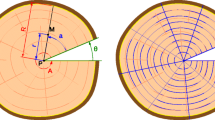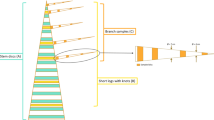Abstract
Density and moisture content (MC) are two of the most important wood performance indexes, which are highly correlated with many other physical and mechanical properties of wood. X-ray computed tomography (X-CT) technology was used to analyze the difference in the CT number of the heartwood and sapwood of Chinese white poplar (Populus tomentosa) and Masson pine (Pinus massoniana) under different MC. Additionally, the fitted models of CT number-density and CT number-MC were established and validated for the heartwood and sapwood of P. tomentosa and P. massoniana. The methodological improvement has been described in detail regarding the established models, which are contrasted and discussed with previous models. The results showed that the CT number-density fitted models of the heartwood and sapwood of P. tomentosa and P. massoniana adopted the linear model: \( D = k \times H + b \), where D is the density, H is the CT number, k is the slope, and b is the intercept. R2 values obtained in the validation models were all higher than 0.98, indicating that the CT number-density fitted models can reliably predict wood density. The CT number-MC fitted models for the heartwood and sapwood of P. tomentosa and P. massoniana adopted the logarithmic model: \( M = \ln ((a + b \times H)^{100} ) \), where M is the MC, H is the CT number, and a and b are the correlation coefficients in the model. R2 values obtained in the validation models were all higher than 0.95, indicating that this model is valid for the accurate prediction of wood MC. The fitted model parameters of heartwood and sapwood indicated that the X-CT technology was effective for identifying the difference in density and MC of heartwood and sapwood. Therefore, it is feasible to use non-destructive testing technology when studying density and MC of heartwood and sapwood based on X-CT technology. The study results provide reference data for the non-destructive testing of wood properties and reasonable utilization.









Similar content being viewed by others
References
Branco LAMN, Chahud E, Christoforo AL, Lahr FAR, Battistelle RAG, Valarelli ID (2014) Influence of moisture content in some mechanical properties of two Brazilian tropical wood species. Adv Mater Res 1025–1026:42–45
Breinig L, Brüchert F, Baumgartner R, Sauter UH (2012) Measurement of knot width in CT images of Norway spruce (Picea abies [L.] Karst.)—evaluating the accuracy of an image analysis method. Comput Electron Agric 85:149–156
Bucur V (2003) Nondestructive characterization and imaging of wood. Springer, Berlin
Davis J, Wells P (1992) Computed tomography measurements on wood. Elsevier Ind Metrol 2:195–218
Eisenacher G, Kuschke C, Schubert S, Neumann M, Sterthaus J, Nitz T, Wille F (2012) Moisture content of wood: influence on mechanical behaviour of wood filled impact limiters and importance for quality surveillance during manufacturing. Packag Transp Storage Secur Radioact Mater 23(3–4):179–185
Espinoza GR, Hernández R, Condal A, Verret D, Beauregard R (2005) Exploration of the physical properties of internal characteristics of sugar maple logs and relationships with CT images. Wood Fiber Sci 37(4):591–604
Freyburger C, Longuetaud F, Mothe F, Constant T, Leban J (2009) Measuring wood density by means of X-ray computer tomography. Ann For Sci 66:804p1–p9
Fromm JH, Sautter I, Matthies D, Kremer J, Schumacher P, Ganter C (2001) Xylem water content and wood density in spruce and oak trees detected by high-resolution computed tomography. Plant Physiol 127:416–425
Han SX (2010) Study on the wood physical properties and defect detection based on CT and fractal characteristics. Dissertation, Northeast Forestry University
He X, Qi D (2013) Density and moisture content forecasting based on X-ray computed tomography. Eur J Wood Prod 71:647–652
Kang XY (2016) Thinking and practices for strategy on a new round genetic improvement of Populus tomentosa. J Beijing For Univ 38(7):1–8
Krauss A (2009) On some aspects of a relation between density and mechanical properties of wood in longitudinal direction. Acta Scientiarum Polonorum Silvarum Colendarum Ratio et Industria Lignaria 8(1):55–65
Li J (2002) Wood science. Higher Education Press, Beijing
Lindgren LO (1991) Medical CAT-scanning: X-ray absorption coefficients, CT-numbers and their relation to wood density. Wood Sci Technol 25:341–349
Lindgren O, Davis J, Wells P, Shadbolt P (1992) Non-destructive wood density distribution measurements using computed tomography. Holz Roh-Werkst 50:295–299
Lindgren O, Seifert T, Du Plessis A (2016) Moisture content measurements in wood using dual-energy CT scanning—a feasibility study. Wood Mate Sci Eng 11(5):312–317
Liu H, Jiang Z, Sun Z, Yan Y, Cai Z, Zhang X (2017) Impact performance of two bamboo-based laminated composites. Eur J Wood Prod 75:711–718
Longuetaud F, Mothe F, Fournier M, Dlouha J, Santenoise P, Deleuze C (2016) Within-stem maps of wood density and water content for characterization of species: a case study on three hardwood and two softwood species. Ann For Sci 73:601–614
Luo YH, Sun DJ, Lin JY, Guo WF, Lu LH, Wen YG (2013) Effect of close-to-nature management on the natural regeneration and species diversity in a masson pine plantation. Acta Ecol Sin 33(19):6154–6162
Luo B, He R, Yang Y (2018) A review of physiological function of sapwood and formation mechanism of heartwood. J Beijing For Univ 40(1):120–129
Osborne NL, Høibø ØA, Maguire DA (2016) Estimating the density of coast Douglas-fir wood samples at different moisture contents using medical X-ray computed tomography. Comput Electron Agric 127:50–55
Radon J (1986) On the determination of functions from their integral values along certain manifolds. IEEE Trans Med Imaging 5(4):170–176
Sandberg K (2006) Modelling water sorption gradients in Norway spruce. N Z J For Sci 36(2/3):347–364
Wang QP (2016) Study on density and moisture detection of wood and bamboo based on X-ray imaging technology. Dissertation, Inner Mongolia Agricultural University
Wang QP, Liu XE, Zhang GL, Yang SM, Ma JF, Tian GL (2016a) Research progress in measurement methods and variation patterns of bamboo density. World For Res 29(2):49–53
Wang QP, Liu XE, Zhang GL, Yang SM, Tian GL, Shang LL, Ma JF (2016b) Rapidly detection for Moso bamboo density under different moisture condition based on X-CT technology. Spectrosc Spectr Anal 36(6):1899–1903
Wang QP, Fei BH, Jiang ML, Liu XE, Yang SM (2018) Hydrothermal aging evaluation method of recombinant bamboo based on X-ray computed tomography technology. Acta Materiae Compositae Sinica 35(4):989–998
Wei Q, Leblon B, La Rocque A (2011) On the use of X-ray computed tomography for determining wood properties: a review. Can J For Res 41:2120–2140
Witomski P, Krajewski A, Narojek T (2010) Measurements of wood density using X-ray computer tomography. Ann Wars Univ Life Sci SGGW For Wood Technol 72:485–489
Acknowledgements
This work was funded by the National Science and Technology Support Plan (2015BAD04B03), National Natural Science Foundation of China (31670565), National Natural Science Foundation of China (31570553), and the Forestry Public Research Foundation (201304513).
Author information
Authors and Affiliations
Corresponding author
Additional information
Publisher's Note
Springer Nature remains neutral with regard to jurisdictional claims in published maps and institutional affiliations.
Rights and permissions
About this article
Cite this article
Wang, Q., Liu, X., Yang, S. et al. Non-destructive detection of density and moisture content of heartwood and sapwood based on X-ray computed tomography (X-CT) technology. Eur. J. Wood Prod. 77, 1053–1062 (2019). https://doi.org/10.1007/s00107-019-01459-y
Received:
Published:
Issue Date:
DOI: https://doi.org/10.1007/s00107-019-01459-y




